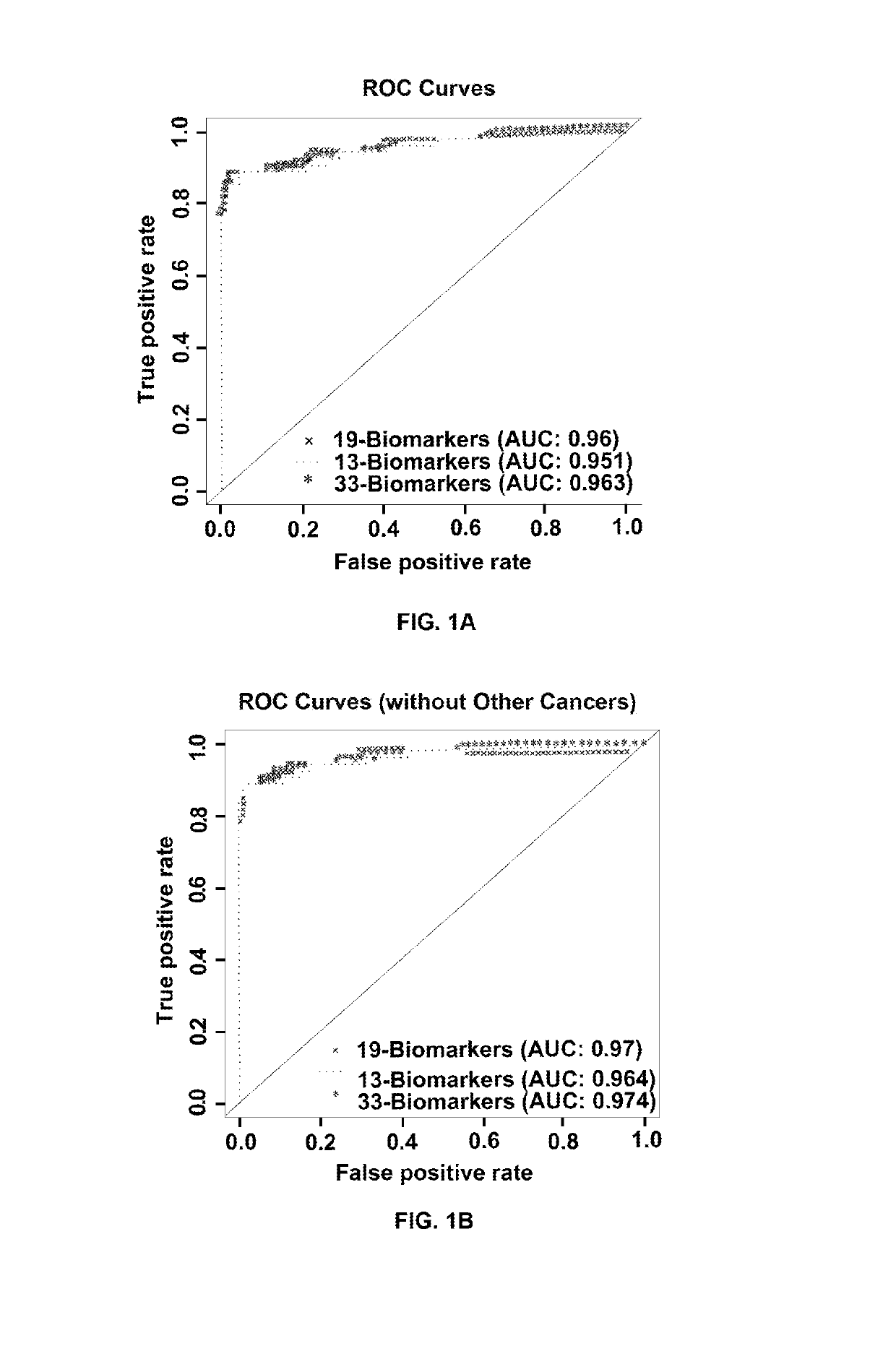Plasma based protein profiling for early stage lung cancer prognosis
a lung cancer and prognosis technology, applied in the field of lung disease detection, identification, and diagnosis, can solve the problems of low survival rate of lung cancer patients, difficult diagnosis early of lung cancer, and inability to define at-risk populations who might benefit from this sort of screening
- Summary
- Abstract
- Description
- Claims
- Application Information
AI Technical Summary
Benefits of technology
Problems solved by technology
Method used
Image
Examples
example 1
Selection of Algorithm to Detect Non-Small Cell Lung Cancer
[0161]Example 1 illustrates the development and assessment of the different algorithms.
Selection of Biomarkers
[0162]This Example describes a procedure used to screen a set of 82 biomarkers to identify a subset of biomarkers that would be useful in a diagnostic method for non-small cell lung cancer which employs nonlinear classifiers to determine whether a patient is likely to suffer from the disease. The set of 82 biomarkers subjected to screening was based on results from prior studies plus 10-15 additional biomarkers that have been reported to have diagnostic potential for early stage lung cancer. The 82 biomarkers are bNGF, CA-125, CEA, CYFRA21-1, EGFR!HER1 / ErBB1, GM-CSF, Granzyme B, Gro-alpha, ErbB2 / HER2, HGF, IFN-a2, IFN-b, IFN-g, IL-10, IL-12p40, IL-12p70, IL-13, IL-15, IL-16, IL-17A, IL-17F, IL-1a, IL-1b, IL-1ra, IL-2, IL-20, IL-21, IL-22, IL-23p19, IL-27, IL-2ra, IL-3, IL-31, IL-4, IL-5, IL-6, IL-7, IL-8, IL-9, IP-10...
example 1a
Review of Algorithms for NSCLC Detection
[0201]Example 1a furtheres the selection of the final algorithm by reviewing additional algorithms: elastic nets, gradient tree boosting, k-nearest neighbors, and Bayesian neural networks.
[0202]The following biomarkers were used for analysis in the final algorithm development: IL-4, sEGFR, Leptin, NSE, MCP-1, GRO-pan, IL-10, IL-12P70, sCD40L, IL-7, IL-9, IL-2, IL-5, IL-8, IL-16, LIF, CXCL9 / MIG, HGF, MIF, MMP-7, MMP-9, sFasL, CYFRA21-1, CA125, CEA, sICAM-1, MPO, RANTES, PDGF-AB / BB, Resistin, SAA, TNFRI, and sTNFRII. Race was not an important factor, and gender was only marginally important in discriminating NSCLC from other pathologies.
Study Samples
[0203]The study samples for Example la are as described in Example 1.
Study Population Criteria
[0204]The inclusion criteria of Example 1 were used for selecting the study population samples this study.
Sample Size Selection
[0205]Sample size selection criteria were the same as the criteria used for Exam...
example 2
Selection of Subgroup of Biomarkers
[0216]Example 2 exemplifies the selection of the 33 biomarkers using Random Forest as the classification algorithm. Selection of Biomarkers
[0217]In this study, 33 biomarkers were selected to have diagnostic potential for early stage lung cancer. The 33 biomarkers are CA-125, CEA, CYFRA21-1, EGFR / HER1 / ErBB1, Gro-Pan, HGF, IL-10, IL-12p70, IL-16, IL-2, IL-4, IL-5, IL-7, IL-8, IL-9, Leptin, LIF, MCP-1, MIF, MIG, MMP9, MPO, NSE, PDGF-AB / BB, RANTES, Resistin, sFasL, SAA, sCD40-ligand, sICAM-1, TNFRI, and TNFRII.
[0218]The Algorithm model for the classifier considers duplicate measurements of 33 biomarkers from a subject, as well as their gender and smoking status, and classifies each measurement by disease state. Using the Random Forest algorithm, each of the duplicate measurements for a subject was classified as having NSCLC or not having NSCLC. If any of the measurements were classified as being from a subject with NSCLC, the subject was class...
PUM
| Property | Measurement | Unit |
|---|---|---|
| diameter | aaaaa | aaaaa |
| temperature | aaaaa | aaaaa |
| Elastic Net | aaaaa | aaaaa |
Abstract
Description
Claims
Application Information
 Login to View More
Login to View More - R&D
- Intellectual Property
- Life Sciences
- Materials
- Tech Scout
- Unparalleled Data Quality
- Higher Quality Content
- 60% Fewer Hallucinations
Browse by: Latest US Patents, China's latest patents, Technical Efficacy Thesaurus, Application Domain, Technology Topic, Popular Technical Reports.
© 2025 PatSnap. All rights reserved.Legal|Privacy policy|Modern Slavery Act Transparency Statement|Sitemap|About US| Contact US: help@patsnap.com

